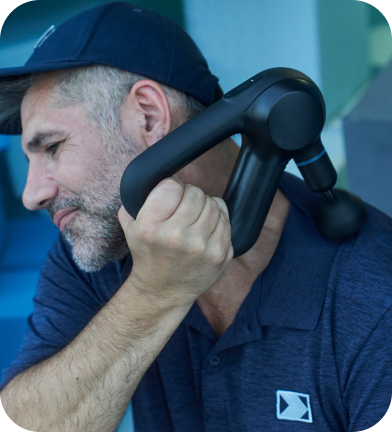Spending long hours sitting at a desk, especially in front of a computer, is a common part of modern life. While this can be productive, it often leads to discomfort in the neck, shoulders, and back. Over time, tightness and stiffness from prolonged sitting can result in chronic pain, limited mobility, and even long-term health problems if left unchecked. Fortunately, there are several effective strategies to mitigate these issues. This post explores a range of techniques including stretching, movement breaks, posture adjustments, ergonomic improvements, heat therapy, professional and self-massage, and tools like massage guns and foam rollers.
1. Heat Therapy: Soothing Muscles with Warmth
Heat therapy is a quick and effective way to relieve tight muscles, improve blood flow, and reduce discomfort in your neck, shoulders, and back.
- Heat Packs or Heating Pads:
Apply heat to the affected areas for 15-20 minutes at a time. A warm compress relaxes stiff muscles and promotes better circulation. Heat therapy can be particularly helpful after a long day of sitting to ease muscle tension before stretching or exercising.
MTC sells homemade heat packs. Stop by our front desk to inquire.
- Warm Showers or Baths:
A warm shower or bath can also help soothe tight muscles, especially when combined with gentle stretching afterward.
2. Massage Gun: Percussive Therapy for Quick Muscle Relief
Massage guns like TheraGun and Sonic Pro are becoming increasingly popular for their ability to provide deep tissue relief at home. They use rapid percussive therapy to massage muscles, improving circulation and helping to break up muscle adhesions or knots.
- How to Use:
Use the massage gun on the affected area for 1-2 minutes, focusing on areas of stiffness. Start with a low setting and gradually increase intensity. Massage guns can be used on the upper back, shoulders, and neck (avoid direct pressure on the spine). - Benefits:
Massage guns help stimulate blood flow, reduce muscle stiffness, and promote quicker recovery after long periods of sitting. They’re especially helpful for people who experience chronic tightness.
3. Foam Rolling: Myofascial Release for Long-Lasting Relief
Foam rolling is a great tool to relieve tight muscles and fascia (the connective tissue that surrounds muscles). This technique, known as myofascial release, helps break up adhesions and increase muscle mobility.
- How to Foam Roll:
Place a foam roller under your upper or lower back, and slowly roll your body across it, pausing on areas that feel tight or sore. You can also use the foam roller to target the shoulders by rolling side to side. Foam rolling works well after a workout or at the end of the day to help loosen muscles.
4. Stretching: Daily Routines to Improve Flexibility and Release Tension
Stretching regularly is one of the most effective ways to relieve muscle tightness and improve mobility. Stretching counteracts the muscle shortening that occurs from sitting for long periods, promoting better circulation and flexibility.
MTC’s Certified Massage Therapist Antonio offers 15-min and 30-min Fascial Stretch Therapy as an add-on to your regular massage sessions. Call (650) 328-9400 to inquire.
5. Movement Breaks: Incorporate Micro-breaks into Your Day
While stretching is important, movement breaks are another critical component to maintaining muscle health. Sitting in one position for too long causes muscles to stiffen, and taking regular breaks to move around helps improve circulation, boost energy, and reduce stiffness.
- Take a Walk:
Every 30-60 minutes, stand up, walk around, and move your arms. Even a brief walk around your office or home helps reset your posture and relieves tension. - Deskercises:
Small exercises you can do at your desk, like seated leg lifts, seated marches, or even just standing and stretching your arms overhead, can all promote circulation and loosen tight muscles. - Postural Shifts:
Throughout the day, change your seated position. Lean back in your chair for a bit, sit on the edge for short periods to activate your core, or try standing with a sit-stand desk. Frequent changes keep muscles engaged and prevent stiffness from prolonged stillness.
6. Improve Your Ergonomics: Optimize Your Workstation Setup
Poor ergonomics is a leading cause of discomfort for people who sit and use computers for long hours. An ergonomically sound workspace like a sit-to-stand riser can drastically reduce the strain on your neck, shoulders, and back, improving both comfort and productivity.
- Chair Support:
Make sure your chair supports your lower back and promotes an upright sitting position. If your chair lacks lumbar support, consider adding a cushion or lumbar pillow. - Monitor Height:
Position your computer screen so that the top of the monitor is at or slightly below eye level, ensuring you don’t have to hunch or tilt your neck down. - Keyboard and Mouse Placement:
Your keyboard and mouse should be positioned so that your arms can stay relaxed at your sides, with your elbows bent at about 90 degrees. This reduces tension in the shoulders and neck. - Foot Support:
If your feet don’t reach the floor comfortably, use a footrest to ensure your hips and knees are aligned and that your feet are resting flat.
7. Massage Therapy: Professional and Self-Massage Techniques
Massage therapy is highly beneficial for releasing deep-seated tension in the muscles. Whether through professional therapy or self-massage, massaging tight areas can help break up knots, improve circulation, and promote overall relaxation.
- Professional Massage:
Consider visiting a licensed massage therapist who can use techniques like Swedish massage, deep tissue massage, or trigger point therapy to target muscle stiffness. Regular sessions can prevent chronic tension and pain.
- Self-Massage:
You can also perform self-massage techniques to release muscle tension at home. Using your hands or tools like a tennis ball or foam roller, you can focus on sore areas of the neck, shoulders, and back. For example, rolling a tennis ball against a wall along your upper back can provide relief for muscle knots
8. Breathing and Relaxation Techniques: Reduce Stress-Related Tension
Stress often manifests as muscle tightness, particularly in the neck and shoulders. Incorporating mindfulness and relaxation techniques can help reduce the stress that contributes to physical discomfort.
- Deep Breathing:
Practice diaphragmatic breathing, inhaling deeply through your nose and exhaling through your mouth. Deep breathing helps reduce tension and promotes relaxation, which can relieve stress-related muscle tightness. - Progressive Muscle Relaxation:
This technique involves tensing and then slowly relaxing each muscle group, helping you become more aware of tension and letting it go.
Conclusion
Tightness and stiffness in the neck, shoulders, and back caused by prolonged sitting and computer use can be uncomfortable and, if left unaddressed, can lead to long-term issues. However, incorporating strategies like regular stretching, movement breaks, ergonomic improvements, heat therapy, massage (both professional and self-massage), and tools like massage guns and foam rollers can make a significant difference in alleviating discomfort. With consistent care and mindful habits, you can mitigate the effects of long-term sitting and improve your overall muscle health and well-being.

